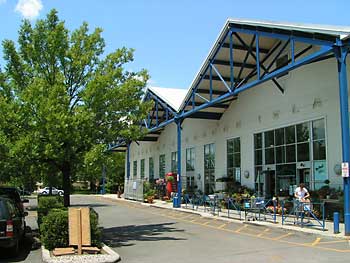
Case Studies
Heritage Property Group, Inc., is a community-focused developer of select retail, service and commercial properties. Heritage is committed to the economic development and prosperity of the communities where it invests.
Since 1992, Heritage has developed projects that require extra concern for the interests of community stakeholders. Heritage has developed “high profile” properties that required managing sensitive environmental concerns including floodway re-mapping, flood plain engineering, EPA remediation strategies, and access design concerns.
Market Square Shopping Center
 2100 Clybourn Avenue, Chicago, IL
2100 Clybourn Avenue, Chicago, IL
Highlights
Community retail center developed in the DePaul area of Lincoln Park.
This development was the first modern retail center on Clybourn Avenue, which has since gained national recognition as one of the most dynamic urban retail districts in the United States.
This 72,000 square foot center is anchored by the internationally known Treasure Island Foods and was designed by award winning Booth Hansen Architects.
An Industrial Revenue Bond authorized by the Illinois Development Funding Authority financed the development of this property.
This project was an important example of urban redevelopment and led to Chicago’s Protected Manufacturing District Ordinance providing standards for commercial buffers between manufacturing uses and residential neighborhoods.
Challenges
Five different neighborhood interest groups had different goals and objectives for the area. Clybourn Avenue was originally intended, in Chicago’s Burnham Plan, to be a commercial corridor. However, since the North Branch of the Chicago River followed Clybourn to the west, the street developed with light manufacturing and industrial uses.
The local manufacturing business owners were very concerned with the encroaching residential re-gentrification, fearing increased pressure from neighbors over environmental concerns.
The neighborhood groups were concerned about the impact on nearby residential properties. The owners objected to having their properties face a very active parking lot and the possible adverse impact on the character of the neighborhood. Small neighborhood food store owners objected to increased competition.
Conventional financing sources were concerned about the pioneering nature of the location and the unproven demand for retail in a light manufacturing corridor.
Solutions
A master plan was developed that created a buffer of townhomes on the north and east perimeters. Masterfully designed new residential townhomes would face older homes and apartments. The shopping center would face Clybourn Avenue creating a commercial buffer between residential and manufacturing uses.
The retail center architecture whimsically reflected the industrial character of the area, with rooflines and entry trusses mimicking historical industrial roof designs. Stores were oriented in a town square format with stores surrounding parking.
Construction and long-term financing was provided by an industrial revenue bond authorized by the Illinois Development Funding Authority.
